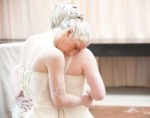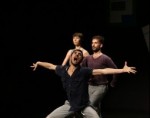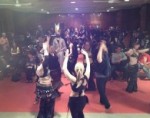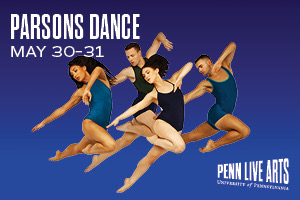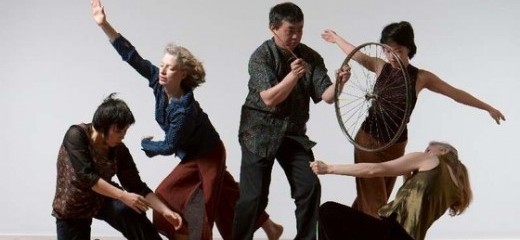
Photo:Lois Greenfield
Contemplative and Connected: Leah Stein’s Singular Aesthetic
By Jim Rutter
Leah Stein has danced and created dances in Philadelphia since 1987. This past weekend at the Performance Garage, Philadelphia Dance Projects organized a retrospective of Stein’s work to celebrate her eponymous troupe’s tenth anniversary. The selections presented gave the sense of a unified aesthetic that informed more than two decades of work.
All of Stein’s pieces showed a contemplative reflectiveness that manifested most clearly in the video of her site-specific Bardo (2005), and the live performances of A Lily Lilies (2011) and Hull (2012). Bardo took place in a vacant lot beside a church; dancers gripped the sides of the building before spinning away along a concrete path. Toshi Makihara stood in neck-high weeds beating an empty jug with a stick for percussion.
In A Lily Lilies, Josey Foo wandered across the stage reciting her poetry as company members enacted the verses’ themes and emotional contours. Two dancers lay on their sides, and a third draped herself over them to form a staircase of bodies that a fourth walked up. Foo spoke of “mapping the earth, for whom the mound is a texture in the air.” Later, she mentioned a hitchhiker; Jung Woong Kim loafed in lazy steps, his thumb stuck outward nonchalantly. David Konyk strode through the recessed area in front of the stage, then grabbed Kim around the waist and hoisted him across his shoulders.
Hull similarly explores a journey, the notion of careening through life with a thin cradle to protect and transport us. It opened to the long wail of a trombone. A few moments later, Konyk entered from off-stage holding the hull of a balsawood boat. Kim suspended it from an overhead wire before he and Michele Tantoco spun it around, pressing it through the air with their hands and heads. They crawled underneath and around it, peering through its fore and aft portals, wondering where it might transport them. The piece concluded as it started, a pair of dancers beached on a shore; the hull—like Charon’s craft—continuing its journey onward. Hull’s ending resonated with the denouement of Lilies, which stopped at the walled edge of a field. The dancers’ gestures of pausing and searching punctuated plaintive lines: “we live in places we do not belong”; “contemplate a world with me in it.”
This sense of place and purpose permeates the video clips that showed Stein’s site-specific pieces, which embody an artful approach to life and a spontaneous, and yet mindful exploration of how the human form fits (or can integrate) into the environment. . Dancers in red dresses ran backward across Longwood Gardens’ fields in Falling from the Sky (2000), dipped their toes and bodies in a fountain’s pool or proceeded in a procession of parasols. Riffs of a trombone played as Josie Smith scooped petals from a stone vase before spreading them in lines accentuating the beauty of manicured lawns. The camera zoomed outward from above, revealing a flock of moving bodies dotting the ordered, sculpted gardens.
Stein created this piece and
Corner Lot (2000) as part of her “
On Site Philadelphia” series, which included works set in Eastern State Penitentiary, Fairmount Park’s Japan House, and Christ Church’s cemetery. They evoke a sense that life abounds in daily ceremonies, no matter how microscopic in nature. Stein gives us eyes to see the potential for beauty in raking stones, dipping our faces in fountains or bounding backward through a field. The vibrancy of movement suggests an imperative: not only
can we dance our way through empty lots and cluttered courtyards, but we
should. Tibetan monks (whose concept of “bardo” she borrowed) and the American transcendentalists Emerson and Thoreau would no doubt agree.
Among Stein’s works, the civil-war themed Battle Hymns stood out in its depiction of futility and barbarity. The remaining pieces, Kite (2002) and the humorous Cabbage Two (1989) displayed a thread of whimsy and her flowing visual aesthetic. All of Stein’s work—even the most contemplative—displayed a communal spirit and a connectedness to the earth.
The evening concluded with Beckon, an improvisation led by Stein and Germaine Ingram. As the two moved to percussive noises made by mouths, tapping feet and hands clapping or slapping thighs, the remainder of the company flowed onto the stage to join them in a frenzy of improvised activity. Even here, Stein’s spontaneous style reflected on how two in tandem—like a jazz duo—can explode in vigor and vitality. No doubt those qualities will sustain the next ten years, as Stein’s singular aesthetic continues to animate Philadelphia’s spaces and sites.
Leah Stein Dance Company 10th Anniversary Concert. Performance Garage, March 8-11. No further performances.
By Jim Rutter
March 16, 2012



